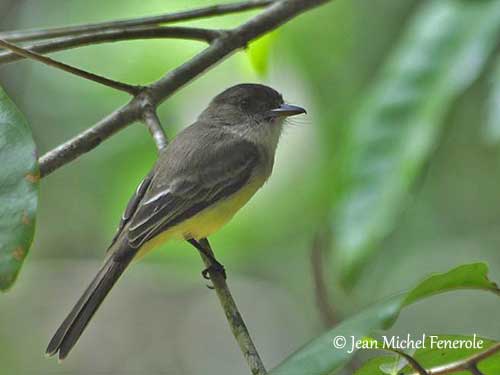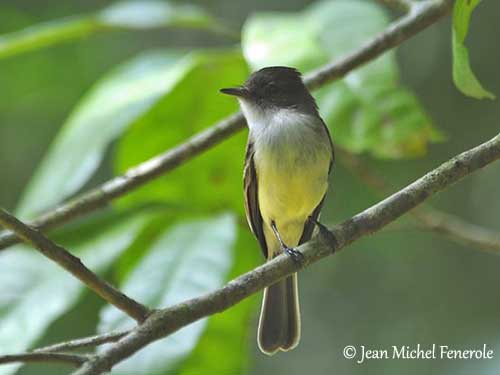
Fr: Tyran triste
Ang: Sad Flycatcher
All: Jamaikaschopftyrann
Esp: Copetón Jamaicano
Ita: Pigliamosche triste
Nd: Jamaicatiran
Sd: jamaicatopptyrann
Photographers:
Jean Michel Fenerole
Photos d’Oiseaux du monde
William Price
PBase-tereksandpiper & Flickr William Price
Dubi Shapiro
Dubi Shapiro Photo Galleries & Dubi Shapiro's Pictures on IBC
Text by Nicole Bouglouan
Sources:
HANDBOOK OF THE BIRDS OF THE WORLD Vol 9 - by Josep del Hoyo - Andrew Elliot - David Christie - Lynx Edicions - ISBN: 8487334695
BIRDS OF THE WEST INDIES – by Herbert Raffaele, Kristin Williams et Tracy Pedersen – Helm – ISBN: 9780713649055
Neotropical Birds – Cornell Lab of Ornithology
Sad Flycatcher
Myiarchus barbirostris
Passeriformes Order – Tyrannidae Family
INTRODUCTION:
The Sad Flycatcher is endemic to Jamaica where it frequents both lowland and montane forests. It is described as common.
It is a member of the subfamily Tyranninae, tribe Attilini. The flycatchers of genus Myiarchus are the most widespread. They nest inside natural or man-made cavities in which they build the nest. They are mainly insect-eaters.
The Sad Flycatcher is common and widespread in Jamaica, but some declines are suspected, due to habitat destruction.

DESCRIPTION OF THE BIRD:
Biometrics:
Length: 16,5 cm
Weight: 11,5-16 g
The Sad Flycatcher is relatively small. The upperparts are olive-brown, with rufous tinge on the uppertail-coverts. The wings are mostly brown with indistinct rufous to cinnamon edges to primaries and secondaries. Two faint pale wingbars are formed by the pale grey tips of greater and median wing-coverts. The tertials have greyish edges. The tail is brown, with rufous outermost webs of some rectrices.
On the underparts, chin, throat and upper breast are pale grey to whitish. Belly and undertail-coverts are yellow, and some yellow may extend onto upper breast. On the underwing, the coverts are yellow.
On the head, the crown is dark.
The broad bill is blackish. The eyes are dark brown. Legs and feet are blackish.
Male and female are similar.
The juvenile has greyish-white breast and throat, with no yellow on breast.
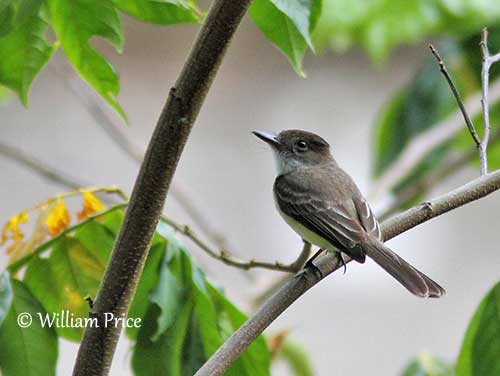
RANGE:
The Sad Flycatcher is found in Jamaica.
HABITAT:
The Sad Flycatcher frequents forests and woodlands from sea-level to 2,000 metres of elevation. It is usually less common in semi-arid lowland areas and in fairly open forests at higher elevations.
CALLS AND SONGS: SOUNDS BY XENO-CANTO
The Sad Flycatcher utters an empathic “pip, pip-pip” or “pip-pip-pireee” rising towards the end. We can also hear a single “huit” usually heard at dawn. This sound is not recorded during the day.
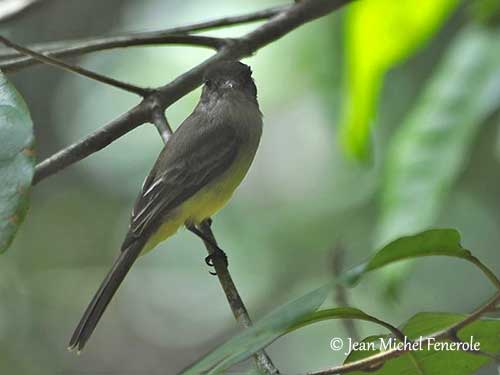
BEHAVIOUR IN THE WILD:
The Sad Flycatcher is an insect-eater and feeds mainly on small insects.
It hunts from perches, usually between 3 and 9 metres above the ground. It sallies to catch insects from leaves. It usually returns to the same perch.
This species is a cavity-nester. The bird builds its nest inside a natural or artificial cavity.
The Sad Flycatcher is resident in Jamaica. It is mainly found at mid-elevations outside of breeding season.
The flight is agile, especially when the bird is foraging, performing short and rapid sallies from perches.
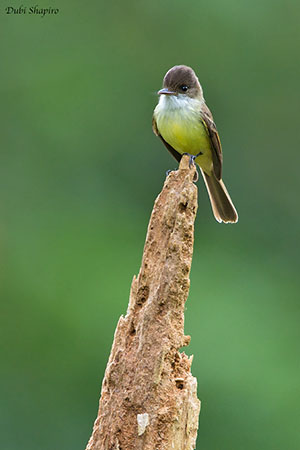
REPRODUCTION OF THIS SPECIES:
The breeding season takes place between April and June.
The Sad Flycatcher builds its nest in natural or man-made cavities. It may use old woodpecker hole, or nests under house eaves, and also holes in coconut palms.
The flycatchers of genus Myiarchus often use pieces of snake and lizard skin, and also hair from mammals, and even plastic to adorn the nest. These materials are used as lining on the nest floor. It seems that the odour of reptile skin is a good protection against predators.
The female lays 3-4 heavily spotted eggs, and she does most of the nesting duties, but the chicks are usually fed by both parents.
The incubation lasts from 12 to 16 days, depending on the species, and the young fledge between 14 and 17 days after hatching.
PROTECTION / THREATS / STATUS:
The Sad Flycatcher has restricted range in which it is common and widespread. However, some decline of the population is due to degradation and destruction of the habitat, especially clearance of much second growth for coffee plantations.
But currently, the Sad Flycatcher is not globally threatened and the species is evaluated as Least Concern.
